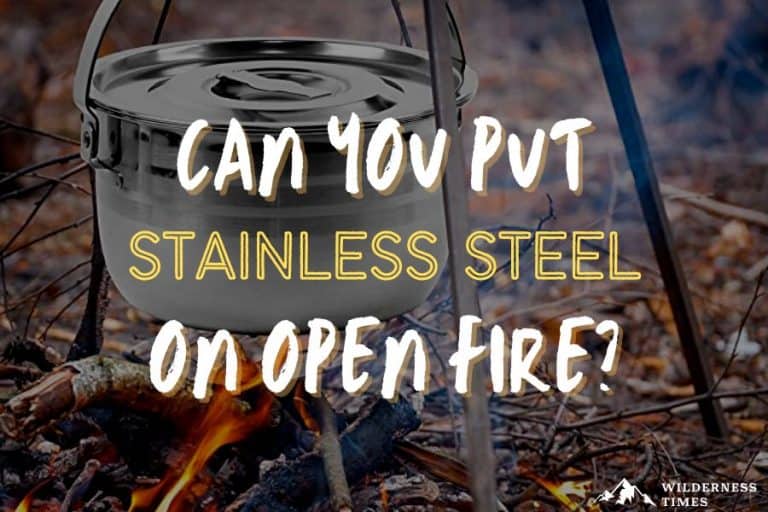After a long day of exploring the wilderness, a hearty meal is the perfect way to wrap up your day.
Sure, you could simply use a camping stove to heat your meal, but what about cooking straight over an open fire?
Can you do it with stainless steel? Yes, you can – but you shouldn’t place it directly onto the fire itself.
Before you go cooking on the open fire, there are some things you need to know about the stainless steel you’re using and the type of fire you’re making.
Let’s dive straight in.
Table of Contents
ToggleCan You Put Stainless Steel On Open Fire?
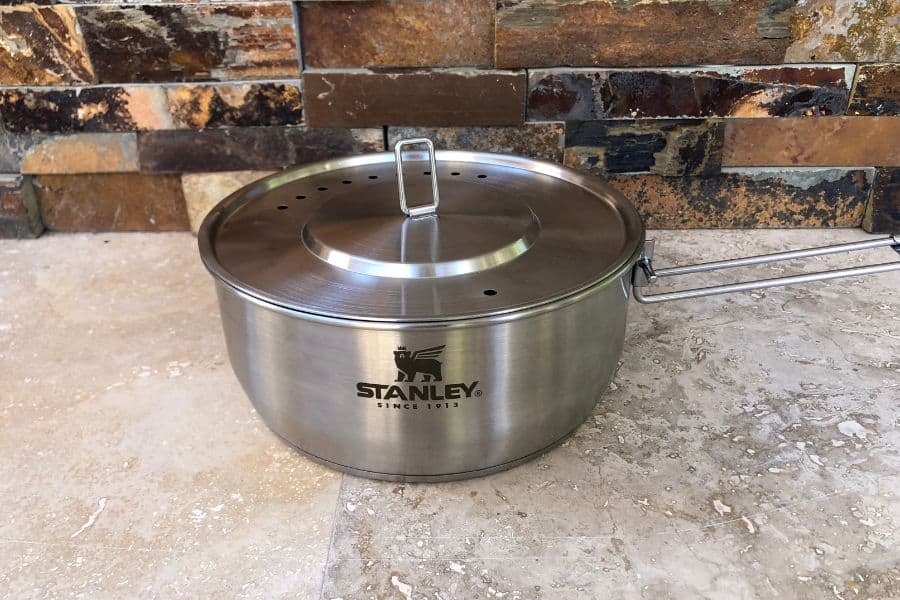
Generally, stainless steel is safe to use over an open fire.
Stainless Steel’s melting point depends on the steel grade, but ranges from 2500 to over 3000 degrees Fahrenheit.
The most common grade used, which is 304 stainless steel, has a melting point of 2552 degrees Fahrenheit (source: kloecknermetals.com).
Campfires, on the other hand, usually reach an internal temperature of 1650 degrees Fahrenheit in flame.
That’s way below the steel’s melting point, but you should still take precautions by never placing your pot directly onto the fire.
Instead, you’re going to want to place the pot above slightly above the flames. Here, you can expect a temperature of up to 600 degrees Fahrenheit.
Most pots and pans made of stainless steel have a slightly lower heat tolerance stated on the label (around 550 degrees).
But you don’t have to worry about flames that are slightly hotter than that. Your pan won’t melt, but its outer part might oxidize, resulting in a darker color on the bottom.
A bit of darkening on the exterior doesn’t affect the performing ability of stainless steel.
With proper care, stainless steel cookware can last for decades.
Because it has a smooth and hard surface, it’s also super easy to clean, which is important for camping.
Plus, since stainless steel is non-reactive, it’s great for cooking acidic food.
Also See: Stanley Adventure Even-Heat Camp Pro Cookset (Review)
How to Put Stainless Steel On Open Fire?
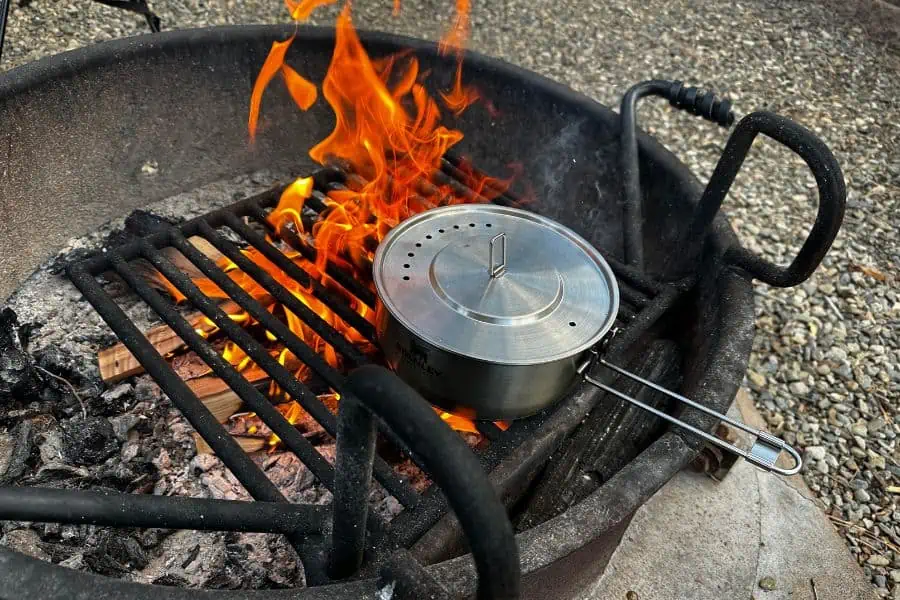
You can’t just place a stainless steel pan directly on an open fire and expect that to work.
That not only can damage your cookware, but also ruin your meal.
Instead, you want to elevate the pot above the fire, where the flames end.
You can do that by placing the grate underneath or suspending the pod with a tripod and wire.
Benefits of Using Stainless Steel on Open Fire
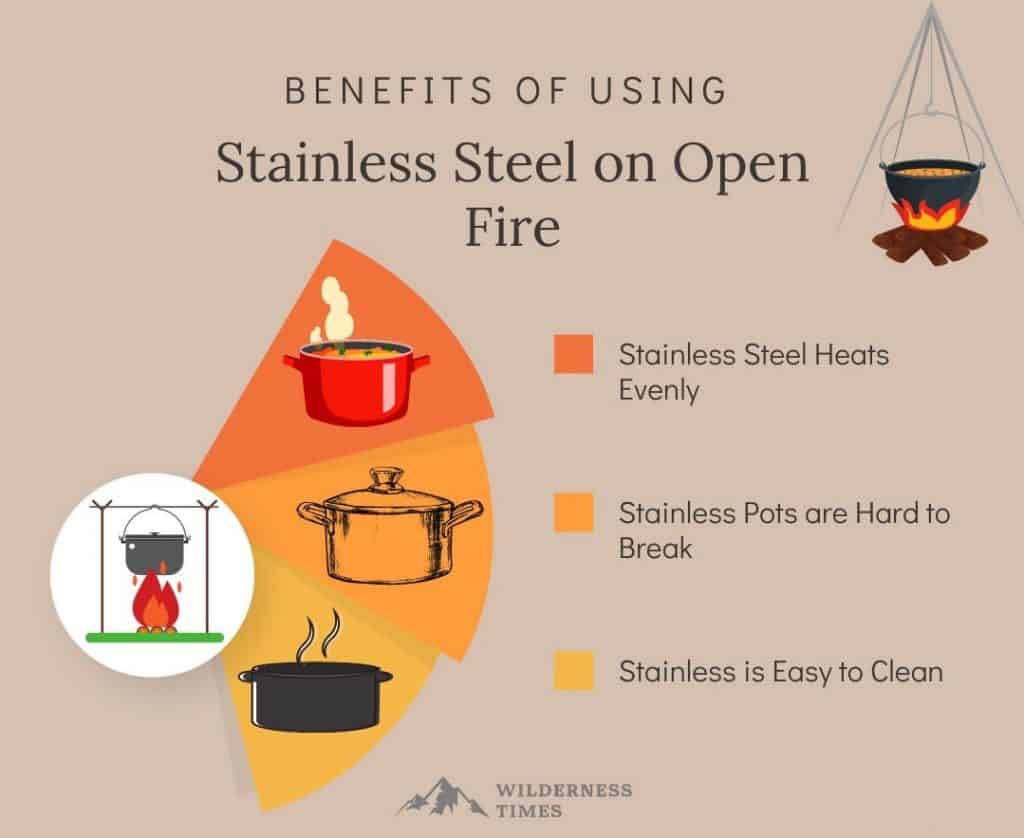
With so many materials available, you might wonder – why stainless steel?
Well, there are a few benefits that make this material great for use on an open fire.
Stainless Steel Heats Evenly
When it comes to camping and backpacking, aluminum and titanium are generally more common choices for cookware.
It makes sense, given that stainless steel can weigh 2 to 3 times more than these two materials.
But when it comes to performance, both aluminum and titanium can develop hot spots.
What this means is they could be warm on one side of the pot and cooler on the other side, resulting in unevenly cooked food.
In fact, hot spots can easily lead to your meal getting burned on some parts.
As for the stainless steel, hot spots aren’t an issue.
It does a great job at distributing heat evenly, so you can easily cook food without getting it burned on an open fire.
Stainless Pots are Hard to Break
If you ever dropped an aluminum pan, then you already know how fragile this material can be.
And when you’re camping, the last thing you want to worry about is damaging your pots and pans.
When it comes to durability, stainless steel is one of the best materials out there. It’s even sturdier than cast iron.
And believe me, you can drop a stainless steel pan all you want, it will bend long before you see it crack.
Who cares if your pot is more square-ish than round if it holds water without leaking? That means it’s still good.
Stainless is Easy to Clean
Some materials can be painfully difficult to clean after cooking. Just imagine a cast iron pan with food pieces stuck on the surface.
You’ll need a sponge, wire scrubber, a gallon of dish soap and tons of luck to make it clean again.
Well, that’s not the problem with stainless steel.
When seasoned and oiled properly, food remains just slide away with water and a bit of soap.
Now, since you’re cooking on an open fire, you can expect your pots and pans to get sooted at the bottom.
Luckily, that’s also relatively easy to clean with steel.
Types of Campfires That Work With Stainless Steel
As we already established, you don’t want to simply put a stainless steel pan on an open fire.
Instead, you want it to sit right on top of the flames.
To achieve that, you’ll have to find a way to elevate the pan. Here are some campfire methods that can work in your case.
Cabin Method
First is my favorite – the cabin method. This is a pretty straightforward way to build a campfire.
Basically, you’re crisscrossing wood in a box shape. First, place two larger logs of wood parallel to each other.
Then, put the next two logs on top of and perpendicular to the first two.
Continue stacking with slightly smaller logs. The more you build, the more it starts looking like a cabin.
Once you’re done doing that, place small twigs and dry leaves in the center of the “cabin.”
Teepee Method
This is the simplest and most commonly used method of building a campfire.
Not just that, but this method creates a steady fire, perfect for cooking.
To build a teepee campfire, first you need to place some tinder in the middle of the designated fire pit.
Then, create a cone with small pieces of kindling surrounding the tinder- basically, keep the pieces upright and leaned against one another.
This campfire method is extremely easy to light up, but it takes some time before the fire is steady for you to cook over it.
You have to wait for the teepee to burn down to a flatter structure, so that you can place a pan over it.
Flat Rock Method
This isn’t a self-contained campfire-building method.
Instead, it’s supposed to be used with either of the two methods mentioned above.
In other words, the flat rock method only shows how to create a proper cooking surface over the two types of the campfire.
As the name suggests, we’ll be using rocks! Well, one rock actually. It should be no more than 2 inches thick.
Place it in the fire pit and build the campfire around it. Then, start the fire. By the time that fire burns down 80%, the
rock will absorb its heat enough to be used for cooking.
I know, it sounds a bit suspicious – but it works! Of course, you don’t want to let the campfire burn all the way, as something needs to keep the rock hot.
Pot Stand
Finally, you don’t have to improvise every time you’re cooking in the wilderness. Truth be told, it can be fun.
But sometimes you just need to make a meal quickly, and can’t be bothered with searching the environment for a rock of a specific size.
If storage space is not an issue, consider getting a pot stand.
These things aren’t generally expensive, and can save you time and effort.
The Best Ways to Clean Stainless Steel Cookware After Camping Cooking
So the food is gone and bellies are full, now what?
Well, now comes the not-so-fun part, cleaning.
After cooking on an open fire, your pots and pans will surely have some soot on their exterior.
You can make a paste with baking soda and water, then apply it to the sooted part of the pan.
Let it rest for an hour, then rinse.
As for the inner part of your pots and pans, it’s always best to start with a paper towel to pick up excess grease.
Then, pour hot water and a bit of dish soap into the cookware and let it sit for a while.
This should get rid of the majority of food scraps.
Of course, there’s always something that doesn’t seem to budge.
But by adding a bit of baking soda into the water and soap mixture, even the most stubborn scraps should be gone.
Some Do and Don’ts of Open Fire Cooking
To finish things up, there are some things that you should always do when using an open fire to cook.
At the same time, some things should be avoided at all costs.
DO Use the Right Firewood
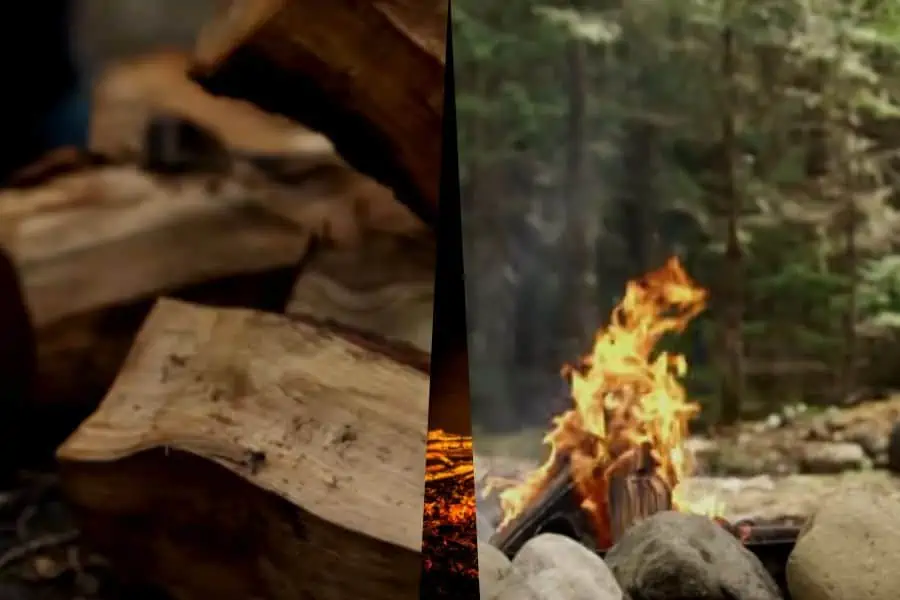
First things first, avoid cutting branches from the trees.
Not only because it’s not an environmentally-friendly thing to do, but because you won’t be able to use it for a campfire.
Fresh branches are the so-called greenwood, meaning they still have tons of moisture inside.
The moisture makes it extremely difficult to burn. And when it finally does, it creates a lot of smoke that you don’t want on your food.
For fire, you want dry wood. But not every dry wood will work either. Hardwood, such as oak, beech and maple will work best.
These types of wood burn hot and steady for hours, with very little smoke.
You want to avoid naturally moist wood that requires seasoning to burn well. These include willow, alder and spruce.
Finally, softwood is not great either, as it contains resin which will make it burn dirty.
But cedar, red pine and fir will burn nicely enough for a campfire.
DO Find a Suitable Location
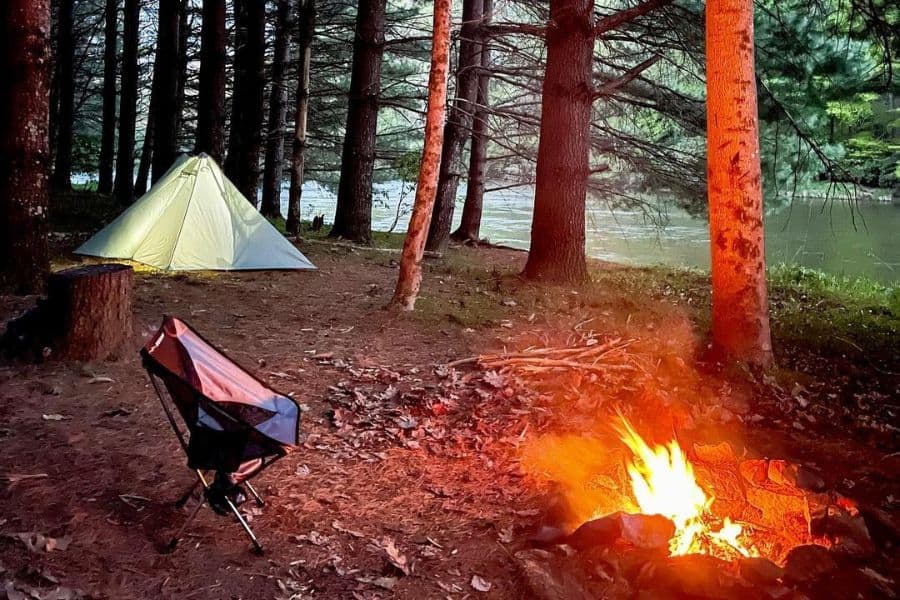
Campgrounds have a designated fire pit for making a campfire.
But when you’re out in the wilderness, it matters where you set up your fire. Ideally, you want to build it on a rock, but if not possible, find a location without grass.
Furthermore, you want to find a location that has some kind of natural windbreak.
Look for rocks, trees and bushes – but make sure you’re not setting up a fire right next to anything that can catch the spark.
DO Get the Right Gear
An open fire is much hotter than your stove. So avoid pots and pans that have any type of coating on the handles, as it will melt.
The same goes for utensils. While you might use plastic utensils at home, they won’t do here. Instead, choose the metal ones.
I’d also recommend wearing appropriate clothes when cooking over an open fire.
These include long sleeves and trousers. Why, you might ask? Well, because sparks and stray embers can burn your skin in contact, so it’s best to protect yourself.
DON’T Cook Directly Over the Flame
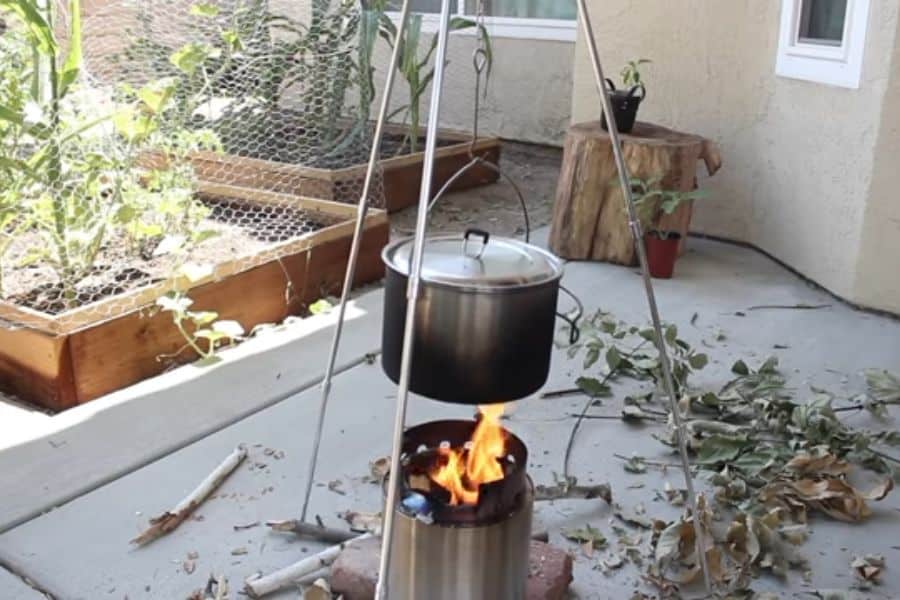
I said it before, but I must say it again – never place your steel pot or pan directly onto the flames.
The closer it is to the center of the fire, the hotter the temperature. Therefore, it can melt.
Instead, place the pot or pan to be above the flames, where the temperature is not higher than 600 degrees Fahrenheit.
DON’T Cook the Food for Too Long
Since the campfire is hotter than the stove, your food will cook faster.
And even after you remove food from the flames, it will carry on cooking for a while resting in the pot or pan.
So for something that takes about 40 minutes to cook at home, it won’t take more than half an hour to be done over an open fire.
DON’T Be Impatient
But while cooking can be faster, heating up definitely takes much longer with an open fire.
You can’t just light up the fire, place a pot over it and start cooking. Proper cooking fire takes time.
You want to slowly feed with firewood throughout the process, and not start everything right away.
An initially large campfire will burn down fast and leave you with just heated-up coals.
But since there are no more flames, nothing can keep them heated for long enough to cook over them.
Instead, give your fire at least half an hour to achieve the desired flame.
Depending on the weather, that amount of time can be even longer. But good food is worth the wait.
How to Season a Stainless Steel Grill Grate
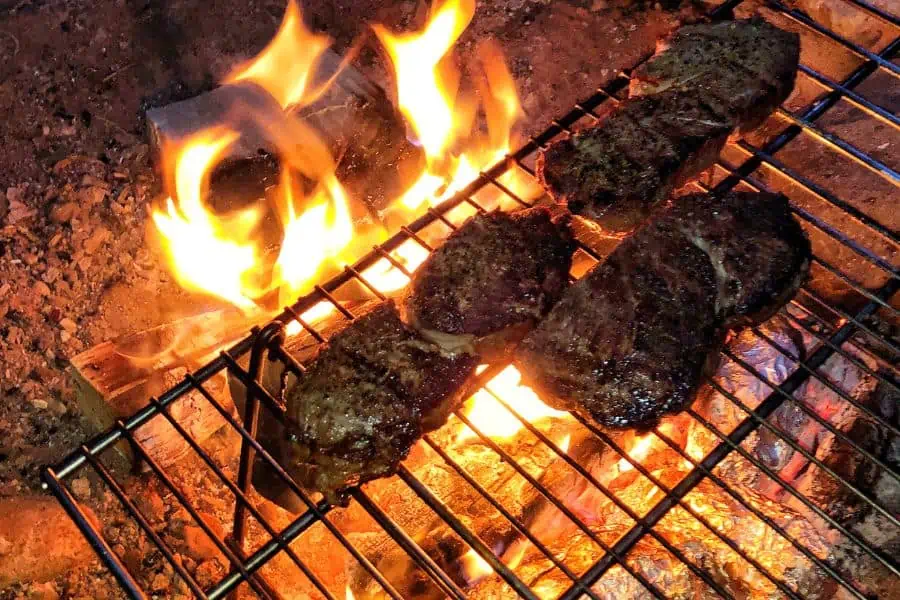
The only thing you need to season a stainless steel grate is – oil.
But not just any oil. What you need is a flavor-neutral oil with a high smoke point.
You don’t want to use something that’s very flammable, or else you won’t be able to season the grate.
Some of the best options are canola, peanut, sunflower, grapeseed and avocado oil.
Stay away from flavored oils, such as olive, sesame and flaxseed, as they have a very low smoking point.
What’s more, avoid using other substances you would at home, such as butter.
To apply the seasoning, you’ll need a paper towel, a grill brush and a spray bottle.
If you’re using a brand-new grill grate, then you won’t need the grill brush right away.
But if you used the grate before, the brush will help you remove the food remains from it.
The next step is to spray the oil all over the grate, then clean the excess with a paper towel.
Once you’re done doing that, you can start the fire. Let the grates warm up for about half an hour before you start using them.
FAQ
Can stainless steel go on fire?
Absolutely, but you shouldn’t place it directly onto it.
Instead, you should either suspend the pot over the fire or use something as a stand.
Make sure the tip of the flames is below the cookware, so that it doesn’t burn your food.
What kind of pan do you use on a campfire?
You can use any type of stainless steel pan on a campfire, as long as it doesn’t have rubber or silicone handles, as they can melt.
Another material that works well with campfires is cast iron.
To Sum Things Up
Stainless steel is a perfect material for camping cookware. It has a high melting point, so it’s safe to use as long as it’s not directly onto the flames.
It’s also easy to clean and very durable, so with little maintenance, it can last you for decades.
Next up: Campfire Safety Tips: How to Stay Safe Around the Campfire


